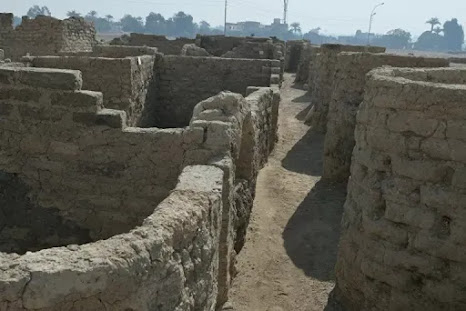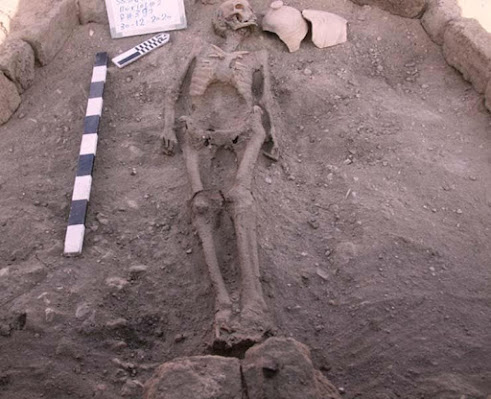Dr. Hawass added that
they started the digging on September 2020, and within weeks, the formations of
mud bricks began to appear in all directions, and they were astonished when
they found that there were about the discover the large city in good condition
of preservation, with rooms filled with tools of daily life.
The place of this city is between the temple of Ramses III in
Madinat Habu and the temple of Amenhotep III in Memnon.
While in the second part of the city they found partially administrative
and residential districts, where we can find bigger and good organized buildings,
and This area is fenced by a zig-zag wall, with only one entry point leading to
interior corridors and residential areas. And this one entrance made us believe
it was a kind of security in terms of being able to control entry and exit into
closed areas.
And in the third part of the city, It was a workshop, as it
includes on one of its sides the production area of mud bricks used to build
temples and annexes, and the bricks contain seals bearing the cartouches of
King Amenhotep III.
A large number of
casting molds have been discovered for producing amulets and delicate
decorative elements, and this is another evidence of the widespread activity in
the city to produce the decorations of both temples and tombs.
Throughout the
excavation areas, the mission found many tools used in industrial activity,
such as spinning and weaving work, and rubble of metals and glass were also
discovered, but the main area for such activity has not yet been discovered.
Two uncommon burials of a cow or bull were also found inside one of the rooms, and the search is still in progress; To determine the nature and purpose of these burials.
A good condition
burial of someone was also found with their arms stretched next to them, and
the remains of a rope wrapped around their knees, the location and position of
this skeleton is somewhat strange, and there is more research on this matter.
A container containing
two gallons of dried or boiled meat (about 10 kg) was found that bears valuable
inscriptions that can be read: “Year 37, boiled meat for Love Day of the Third
Dam from the butchery of “Kha” made by the butcher “Iwi”.
This valuable
information not only gives us the names of two people who lived and worked in
the city, but also confirms that the city was active and determined the time of
King Amenhotep the Third's participation with his son Akhenaten.
The team also found a
text inscribed on the imprint of a seal that reads: “Gem Ba Aten” meaning the
province of bright-Aton, and this is the name of a temple built by King Akhenaten
at Karnak.
A large cemetery was
uncovered, the extent of which has not yet been determined, and the team discovered
a group of tombs carved into the rocks of various sizes, which can be accessed
through stairs carved into the rock, and there is a common feature of building
tombs in the Valley of the Kings and the Valley of the Nobles.
The work is still in
progress and the team expects to uncover untouched tombs full of treasures.









I wanted to thank you for this excellent read!! I definitely loved every little bit of it. I have you bookmarked your site to check out the new stuff you post. Government house hobart
ReplyDeleteAwesome article, it was exceptionally helpful! I simply began in this and I'm becoming more acquainted with it better! Cheers, keep doing awesome! Musandam dhow cruise offers Travel refers to the act of moving from one location to another. This can refer to long-distance travel, short-distance travel, overseas travel, domestic travel and various other forms. Crucially, travel also includes both round trips and one-way journeys, and it covers a wide variety of different travel purposes.
ReplyDelete